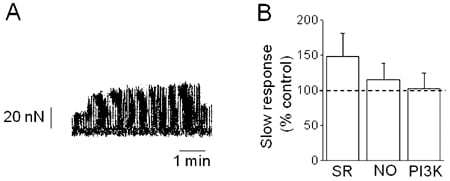A slow increase in Ca2+ and contraction (the slow response) is seen when cardiac myocytes and muscle are stretched. Vila-Petroff et al. (2001) recently proposed that activation of the PtdIns-3-OH kinase-Akt-NO axis leading to enhanced RyR activity underlies the slow potentiation of the [Ca2+]i transient in rat ventricular myocytes stretched within an agarose gel. We have examined the role of the PtdIns-3-OH kinase-Akt-NO axis and the sarcoplasmic reticulum (SR) in the slow response evoked by stretch of myocytes with carbon fibres.
Rats were killed humanely, and enzymatically isolated ventricular myocytes were stretched following attachment to two carbon fibres. The slow response (force at 5 min as a percentage of that at 10 s after stretch) was recorded under control conditions and after pharmacological intervention in the same cell. Sarcomere length was used as the index of stretch.
Figure 1A shows the biphasic increase in force upon stretch observed in a representative cell. No reduction in the magnitude of the slow response was observed when SR function was inhibited with 1 µM thapsigargin and ryanodine (6.4 % stretch; n = 4; P > 0.05, Student’s paired t test; Fig. 1B). The NO synthase inhibitor L-NAME (1 mM) had no impact on the slow response (8.3 % stretch; n = 7; P > 0.05; Fig. 1B). Furthermore, unloaded myocytes showed only negative inotropic responses to exogenous supply of NO using the donor S-nitroso-N-acetylpenicillamine (SNAP; 1-100 µM), although the reduction in shortening observed with 100 µM SNAP was absent in the presence of 1 mM L-NAME. Inhibition of PtdIns-3-OH kinase with 10 µM LY294002 had no effect on the slow response (8.2 % stretch; n = 6; P > 0.05; Fig. 1B).
We find that the slow response observed in single rat myocytes stretched by carbon fibres does not depend on activation of PtdIns-3-OH kinase, generation of NO, or a functional sarcoplasmic reticulum. We have previously shown that the stretch-activated channel plays a major role in the slow response observed in cells stretched by carbon fibres (Calaghan & White, 2002). The present data contrast with those of Vila-Petroff et al. (2001) who proposed the RyR as the final effector underlying the slow response. The method by which cells are stretched may have profound consequences for the activation of intracellular signalling cascades, perhaps depending on the extracellular connections/support of the cell.
This work was supported by the BHF.

